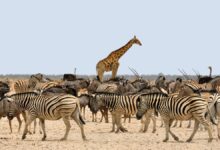Antelopes: Graceful Runners of the Savanna

Antelope: Graceful Runners of the Savanna
Antelope
Introduction
Antelopes are among the most graceful and agile animals found in Africa and Asia’s grasslands, savannas, and deserts. Known for their sleek bodies, powerful legs, and swift movements, antelopes are a diverse group with various species, each adapted to their unique habitats.
Scientific Overview
Scientific Name
Antelopes do not belong to a single genus or species; they’re a group of over 90 species under multiple genera within the family Bovidae.
Common Name
They are collectively called antelopes, though each species has a distinct name, like the Gazelle, Impala, and Kudu.
Scientific Classification
Types of Antelope
There are many antelope species, including:
- Gazelle
- Impala
- Kudu
- Eland
- Sable Antelope
- Springbok
- Oryx
Each species has specific adaptations and distinct features suited to its environment.
Habitat and Distribution
Antelopes are native to Africa and parts of Asia, inhabiting diverse landscapes from open savannas and grasslands to woodlands and deserts. Some species, like the Springbok, thrive in arid regions, while others, like the Nyala, prefer dense woodlands. The African continent is home to most antelope species, with countries like Kenya, South Africa, and Tanzania hosting a wide range of these animals.
Physical Characteristics
Size and Weight
Antelopes vary greatly in size depending on the species:
- Elands are the largest, with males weighing up to 2,000 pounds.
- Dik-Dik is one of the smallest, weighing only around 7-15 pounds.
Appearance
Antelopes typically have slender, muscular bodies built for speed and agility. Their coats vary in color, from tan and brown to shades of black and white, often with distinct markings or patterns to aid in camouflage. Many species have horns, which can vary in shape and size between species and are typically larger in males.
Diet and Feeding Habits
Antelopes are herbivores with a diet consisting primarily of grasses, leaves, and shrubs. Some species, like gazelles, are grazers that prefer short grasses, while others, like kudus, are browsers that feed on leaves and fruits from trees. Antelopes have specialized digestive systems, including a four-chambered stomach, to extract maximum nutrients from their plant-based diets.
Predators and Threats
Antelopes face various natural predators, including:
- Big Cats: Lions, leopards, and cheetahs are primary threats.
- Wild Dogs and Hyenas: They often hunt in packs, preying on young, sick, or isolated individuals.
- Humans: Hunting and poaching pose significant threats to some antelope species.
In addition to predation, habitat loss due to agriculture, urbanization, and climate change is a growing concern for antelope populations.

Reproduction, Calves, and Lifespan
Antelopes typically give birth to one calf after a gestation period of about six to eight months, although some species may have twins. The timing of births is often synchronized with the rainy season when food is more abundant. Calves can stand and move within hours of birth, allowing them to quickly escape from potential predators. The lifespan of antelopes varies by species but generally ranges from 10 to 20 years in the wild.
Population and Conservation Status
The conservation status of antelope varies widely across species:
- Endangered Species: The Addax and Saiga antelope are critically endangered due to poaching and habitat loss.
- Stable Populations: Certain species like the Springbok and Impala have stable populations thanks to protected reserves and game management.
Conservation efforts focus on habitat protection, anti-poaching initiatives, and the establishment of wildlife reserves. Organizations like the IUCN and WWF work closely with local governments and communities to ensure antelope populations are preserved.
Behavior and Social Structure
Herding and Social Behavior
Most antelope species are social animals that live in herds, which provide safety in numbers against predators. Herd size can range from small groups to thousands, as seen in species like the wildebeest during migration. Some antelopes, like the dik-dik, are more solitary and are usually found in pairs.
Communication and Alertness
Antelopes use a variety of vocalizations, body language, and scent markings to communicate. They are highly alert animals, with keen senses of sight, smell, and hearing, allowing them to detect predators early and flee if necessary.
Ecological Role
Antelopes play a crucial role in their ecosystems by influencing vegetation growth through grazing and providing prey for large predators. Their grazing helps maintain the health of grasslands, preventing overgrowth and supporting biodiversity. Additionally, their movements across habitats contribute to seed dispersal, promoting plant diversity.
FAQs About Antelopes
- Why are antelopes so fast?
They have evolved to be swift runners to escape predators. Their long, muscular legs and streamlined bodies are adapted for high-speed running. - Do antelopes migrate?
Some species, like the wildebeest, are known for their seasonal migrations in search of food and water, especially during dry seasons. - Are antelopes endangered?
Some species, like the Saiga and Addax, are endangered due to poaching and habitat loss. However, other species, such as the Springbok, are abundant. - What do antelopes eat?
They are herbivores, with diets consisting of grasses, shrubs, and leaves. Their diet varies based on species and habitat. - How long do antelopes live?
They typically live between 10 and 20 years in the wild, depending on the species and environmental conditions.
Conclusion
Antelopes are extraordinary animals, with remarkable adaptations that allow them to thrive in various environments. From the swift gazelles to the powerful elands, each species contributes to the biodiversity and balance of their ecosystems. Conservation efforts are essential to protect these graceful creatures from threats like habitat loss and poaching. By supporting these initiatives, we can help ensure that antelopes continue to roam the wild landscapes of Africa and Asia for generations to come.


